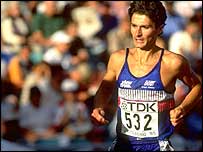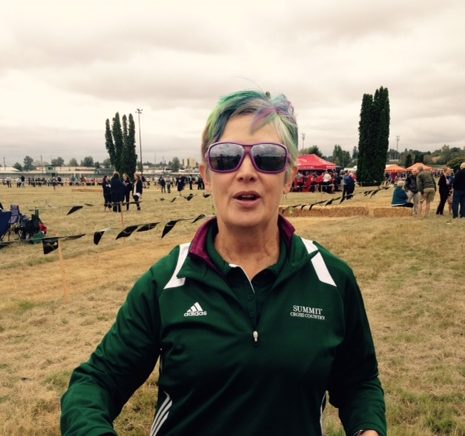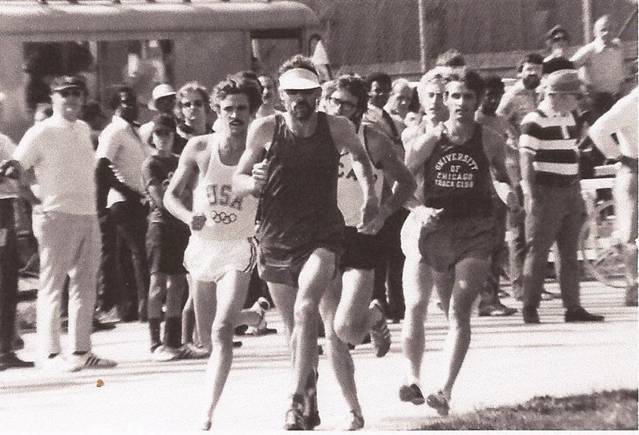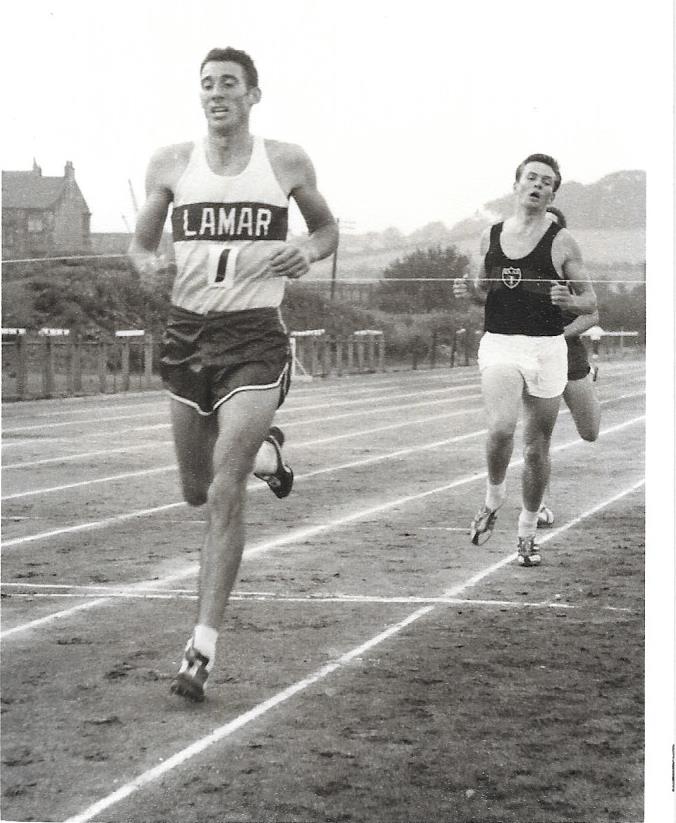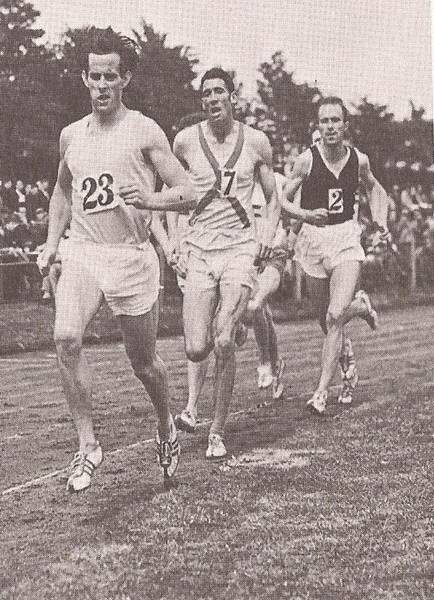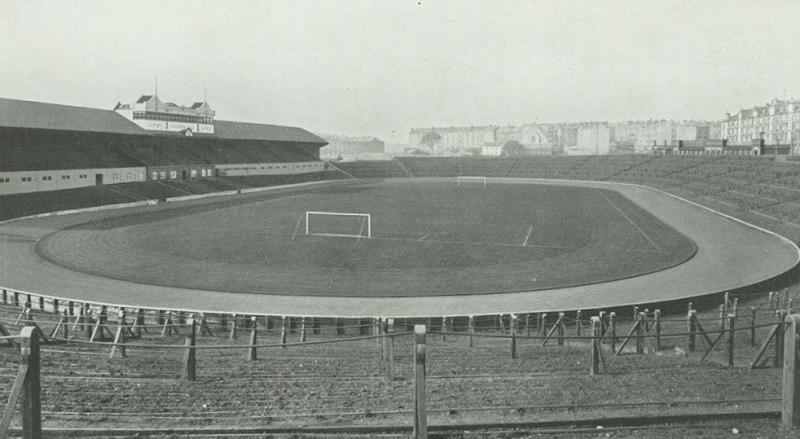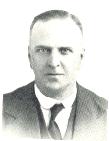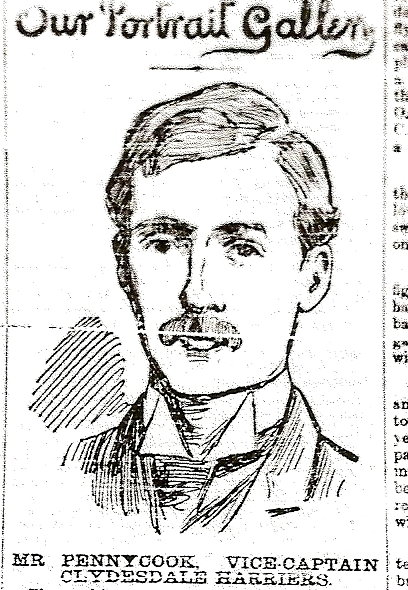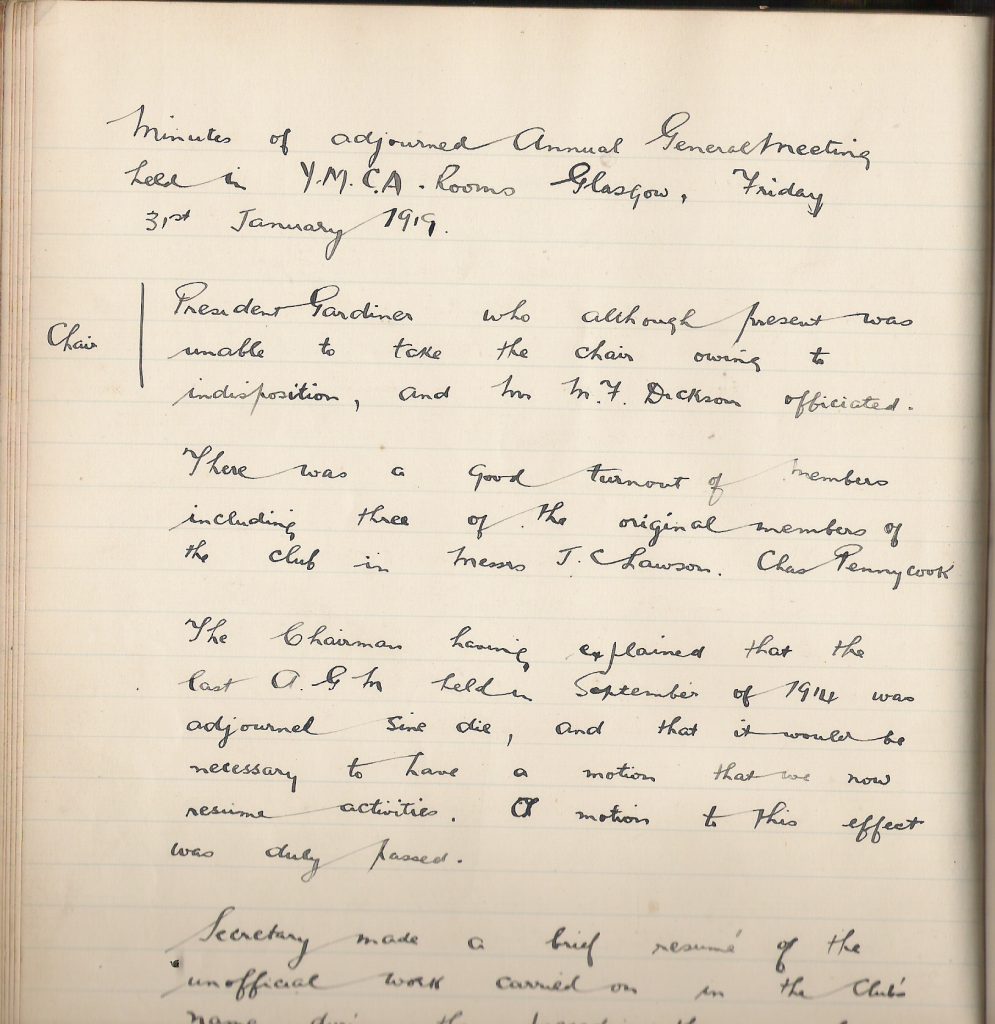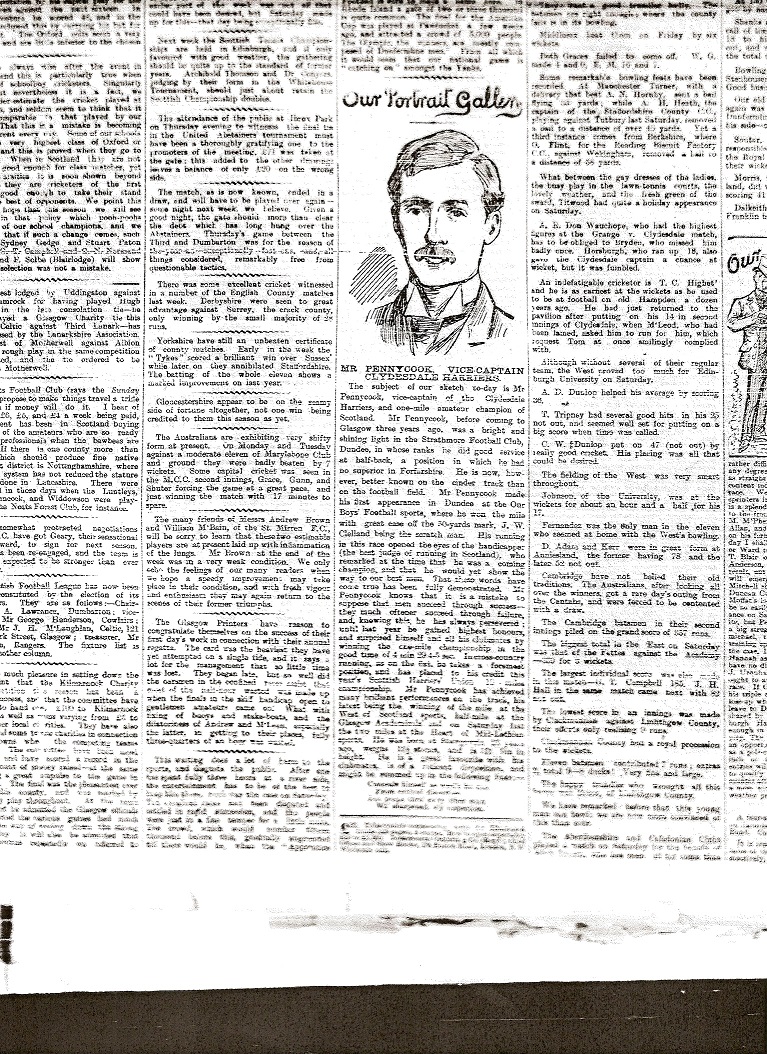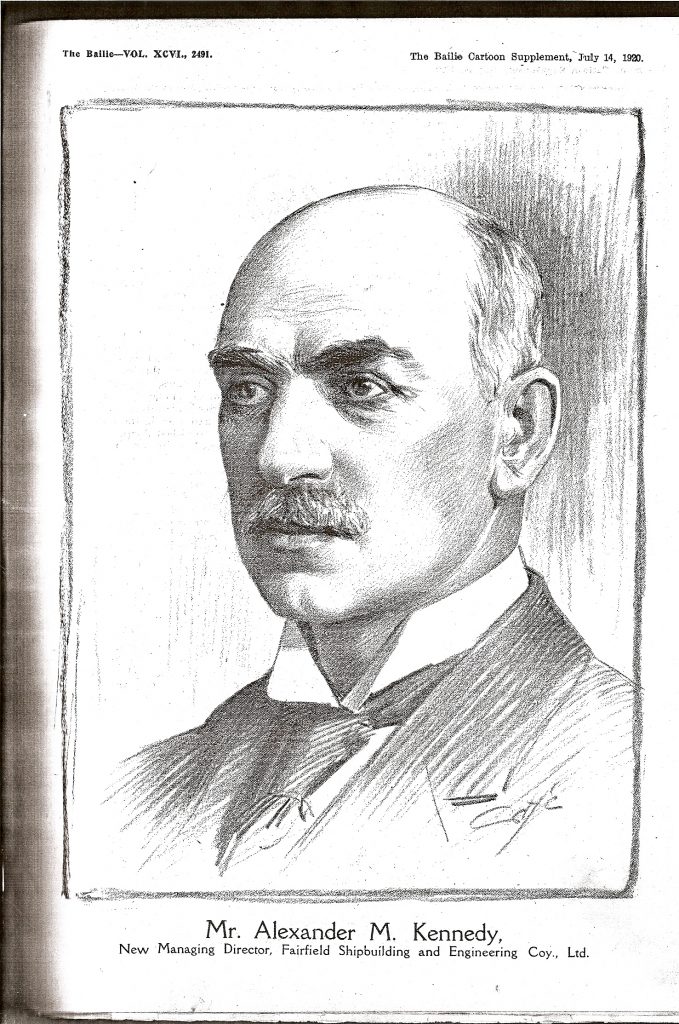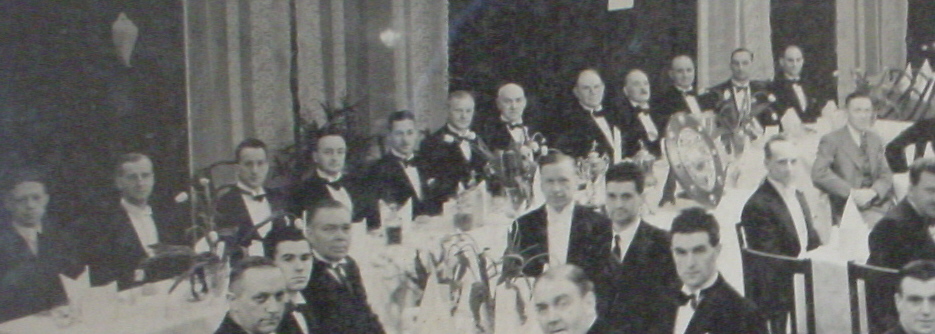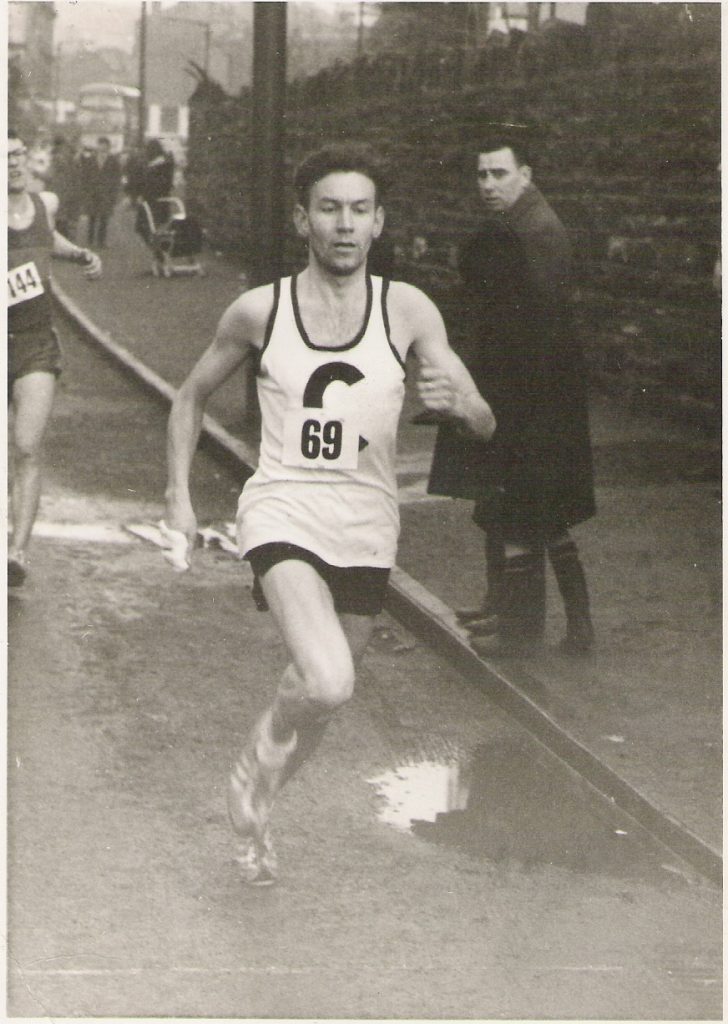
Ian finishing the Nigel Barge Road Race
Ian took up athletics as a Senior Man in 1963. He had first got into athletics in his National Service days when as an aspiring football player he was drafted into the Battalion Athletics team in 1960 and in the Inter Battalion Sports he won the 5000 metres on grass in standard Army issue plimsolls. After leaving the Army he still pursued his football dream “until I got fed up carrying other less fit team mates and retired from the sport”. Having moved to Old Kilpatrick in 1963 he was looking out of the window one day and saw a group of runners going by. He asked where they trained from, found out it was the Clydebank Public Baths at Bruce Street. When he made his way there he met club captain Johnny B Maclachlan (who also lived in Old Kilpatrick) and caught the running bug. He had already seen all the greats on television in the late 50’s and early 60’s. His words: “I vividly remember Chris Chataway and Vladimir Kuts slogging out a very exciting 5000 metres. Names like Gordon Pirie, Derek Ibbotson, Roger Bannister, Bruce Tulloh and many others appeared on the magic box bringing live athletics into the living room.”
As said above he joined the club first of all in 1963 and was a first team runner running well enough to win team medals without being spectacularly good or spectacularly bad. Of that first period he says “I have many very happy memories of club training nights every Tuesday and Thursday down in the basement of the Baths. There were three different running packs, slow, medium and fast, setting off at intervals with the route laid out on the notice board. My favourite training run was up Kilbowie Road, along the Boulevard to Bowling AA Box and home along the low road which became a bit of a burn up!
We were fortunate having these facilities (Bruce Street Baths) which were warmed by the lagged pipes but the ‘piece de resistance’ was the sing-song in the shower afterwards. Frank Kielty, Pat Younger and Gerry Hearn gave us a rendering of many bothy ballads that made the rafters ring!”
He goes on to say that another feature of these days was the inter club run at various other clubs’ headquarters. On one trip to Greenock for a run with the Glenpark Harriers we had a few guys who didn’t turn up and another club didn’t show at all. After the run it was customary for the home club to provide a snack: at this one there was a more than ample supply of mince pies to go round and we all felt obliged to consume more than our fair share. He finishes by saying he never wants to see another mince pie in his life!
He was a good club runner in those days and his first ever race for the club – the County Relays at Garscube which the club won – saw him walk away with his first gold medal. The following year when Ian Donald joined the club, Ian was a member of the team which won the Dunbartonshire Relays and gave the ‘other Ian’ his first gold for the club. He ran well in most races and he turned out often for the club not only in championship and open races but also in inter club runs.
We were very sorry when he emigrated with his family to Whyalla in Australia in 1966. He still pursued his athletic activities as well as going back to playing football. Joining the Whyalla Harriers Club, he rose to become club President. Athletics were track motivated down under because of the warm weather and there were generally very few road races which were concentrated in the big cities. The main competitions in South Australia were called ‘Gift Meetings’ similar to our Highland Games where the Blue Ribbon event was usually the Mile where (unlike the UK) money incentives were the norm. At the start of 1966 he was torn between ‘soccer’ and athletics and having decided on athletics he ran in the Commonwealth Marathon Trial. Unplaced, he turned back to football. Normally a forward he played wing half and when the captain and centre half was injured he substituted in the position. He was so effective that he kept the position and led the team to the Northern Areas Soccer Association Cup. He also played for Croatia and City Football Team while there. He kept on running though and also kept in touch with the club back home. He returned to Clydebank after only a few years in 1969.
When he returned his running had been transformed. He enjoyed the cooler atmosphere and the road racing circuit that had been absent in Australia. He was a now an outstanding athlete who had gained confidence while he was away and became one of a top squad of runners who served the club well throughout the late Sixties and into the Seventies. Most of us remember him as a very good cross country runner but he was just as much a track and road runner and even dabbled in hill running with some success. For instance, he ran in the Mamore Hill Race in July 1969 finishing in 1:52:18 as part of the winning team. Ian also tackled the Big Ben (Ben Nevis) in September 1972 and finished in 3:00:54.
His best years were probably from 1969 to about 1973 and the best single year was possibly 1969/70. His Cross Country Running in the four years after his return can be summarised as follows:
| |
1968 – 1969 |
1969 – 1970 |
1970 -1971 |
1971 – 1972 |
| McAndrew
Relay |
A Team:
3rd Fastest |
A Team:
Fastest |
A Team:
2nd Fastest |
A Team:
2nd Fastest |
| County Relay |
A Team:
3rd Fastest |
A Team:
Fastest |
A Team:
2nd Fastest |
A Team:
2nd Fastest |
| District Relay |
A Team:
Fastest |
A Team:
Fastest |
DNR |
DNR |
| Edinburgh to
Glasgow |
First Stage
15th |
Sixth Stage:
13th |
Third Stage:
4th |
Fourth Stage:
7th |
| |
|
|
|
|
| County Championships |
IL 2nd , ID 1st, RS 3rd, DG 6th |
IL 3rd, ID 4th, DG 5th, RS 7th |
IL 2nd, ID 3rd, DG 5th, SMcN 10th |
AF 1st ; IL 3rd , DG 4th , 5th ID |
| District Championships |
IL 4th, ID 12th, DG 20th. |
IL 23rd, RS 24th, PD 50th. |
AF 13th, IL 18th, PD 22nd |
AF 6th, DG 11th, PD 24th, ID 25th, IL 31st |
| National Championships |
IL 31st, ID 37th, RS 50th |
AF 27th, IL 31st, DG 42nd, ID 59th, RS 60th |
DNR |
DNR
Three Day Week* |
* In February 1972 there was a power workers strike and the country was restricted to three days work a week. Depending on the job you were doing, you might not have been able to run on Saturday. Ian came into this category.
A YEAR IN THE LIFE …
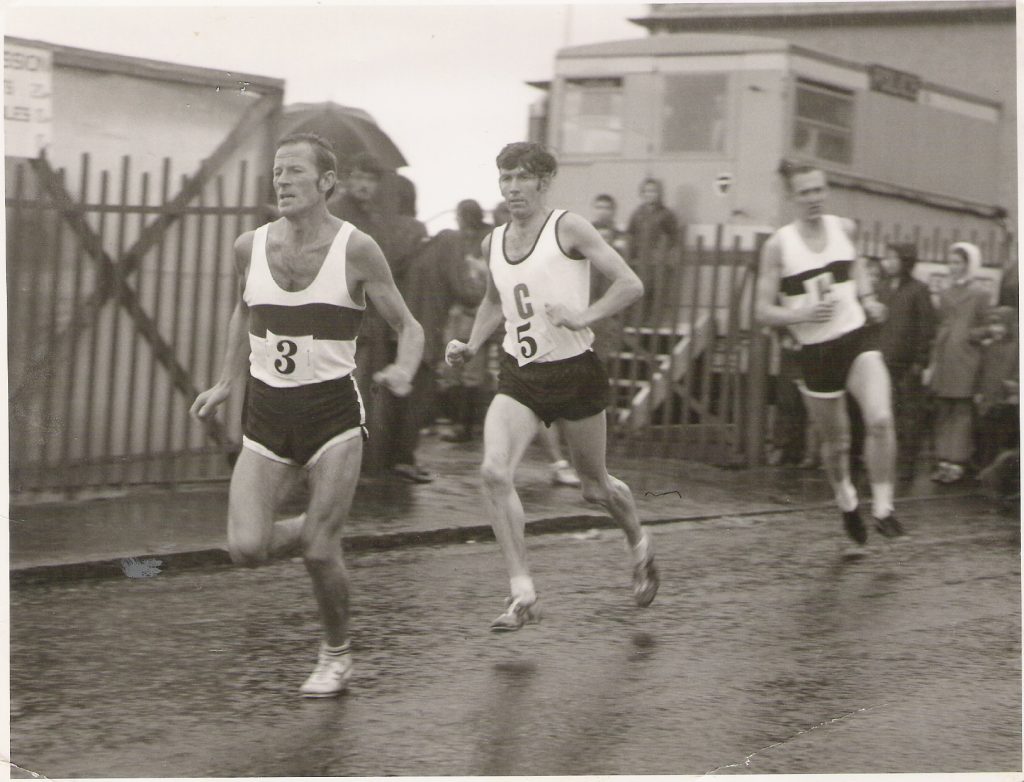
His form on his return was good and he won so many trophies at the time that it might be appropriate to look at 1969 in a bit of detail. On the Saturday before Christmas, 1968, he had the fastest time in the club Christmas Handicap being 41 seconds faster than I was and a minute and a half quicker than Phil Dolan. 1969 started with the classic Nigel Barge Road Race at Maryhill and he was twenty second of the 168 finishers – two places behind Ian Donald and two ahead of Douglas Gemmell and the team was third. A week later was the club’s Six Mile Race for the Hannah Cup and he had second fastest time again behind Ian Donald. The tables were turned on Ian next week when in the Midland District Championship Ian had what was maybe his best ever run in the event finishing fourth with Ian Donald twelfth and Douglas twentieth. After the closely fought race the Scottish cross country captain Andy Brown of Motherwell said that had Ian run at a steadier pace throughout he would certainly have had a medal. He followed this by a superb run in the Inter Counties at Cleland Estate, Motherwell, which he rates as possibly his best ever race, finishing second to International athlete John Linaker of Motherwell YMCA. The ‘Glasgow Herald’ had ‘Linaker beat the improving Ian Leggett (Clydesdale) by 280 yards in 33:12’. Ian Donald was twelfth in the race and Douglas twentieth. He was second again a week later – to Ian in the club championship But in the National Championships in Edinburgh two weeks later he turned the tables again finishing thirtieth – five places ahead of Ian – to be the club’s first finisher.
On the roads his summer campaign started with fifteenth place in the Tom Scott 10 Miles Road race in 51:56. A week later – 19th April – he was second in the club three miles championship in 15:08 which was four seconds behind Ian. Came the Clydebank to Helensburgh and he was fourth and first club finisher in 1:30:04. Back to the ten miles distance the following week – this time in the SAAA Track Championship where he was eighth on the cinders of Scotstoun in 54:14. He skipped the club 880 and One Mile championships and then ran in the Drymen to Scotstoun 15 Miles Road Race where he was seventh in a good field on a very hilly course. He stayed on the road for his next race which was the 13+ miles at Airdrie Highland Games where he was second to Victoria Park’s Pat McLagan in 67:13. A week later (14th June) and he was third in the 14 Miles of the Babcock and Wilcox Road Race at
Renfrew in just over 79 minutes. At the start of July the club was involved in an invitation 3000 metres race at the Glasgow Transport Sports Meeting. Ian was fifth, nine seconds ahead of Douglas and thirteen ahead of Ian Donald. Later in the month at the Gourock Highland Games (pictured above, left, leaving the ground) he was a good third in the 14 miles road race. His run in the very tough 14 mile Mamore Hill Race in July has already been mentioned. The Mamore starts in Kinlochleven and has a mile and a half on the road before climbing on to the Lairig Mhor towards Fort William. After climbing up to the approximately 2500 feet shoulder of the hill, the course drops to the road and finishes with seven miles on the tarmac. The club has a good record in this race with Ian Donald, Bobby Shields and Phil Dolan all having broken the record at one time or another. Ian Donald in 1967 was leading by a distance and within the record when his legs just gave out on him with the last two miles on the road to go
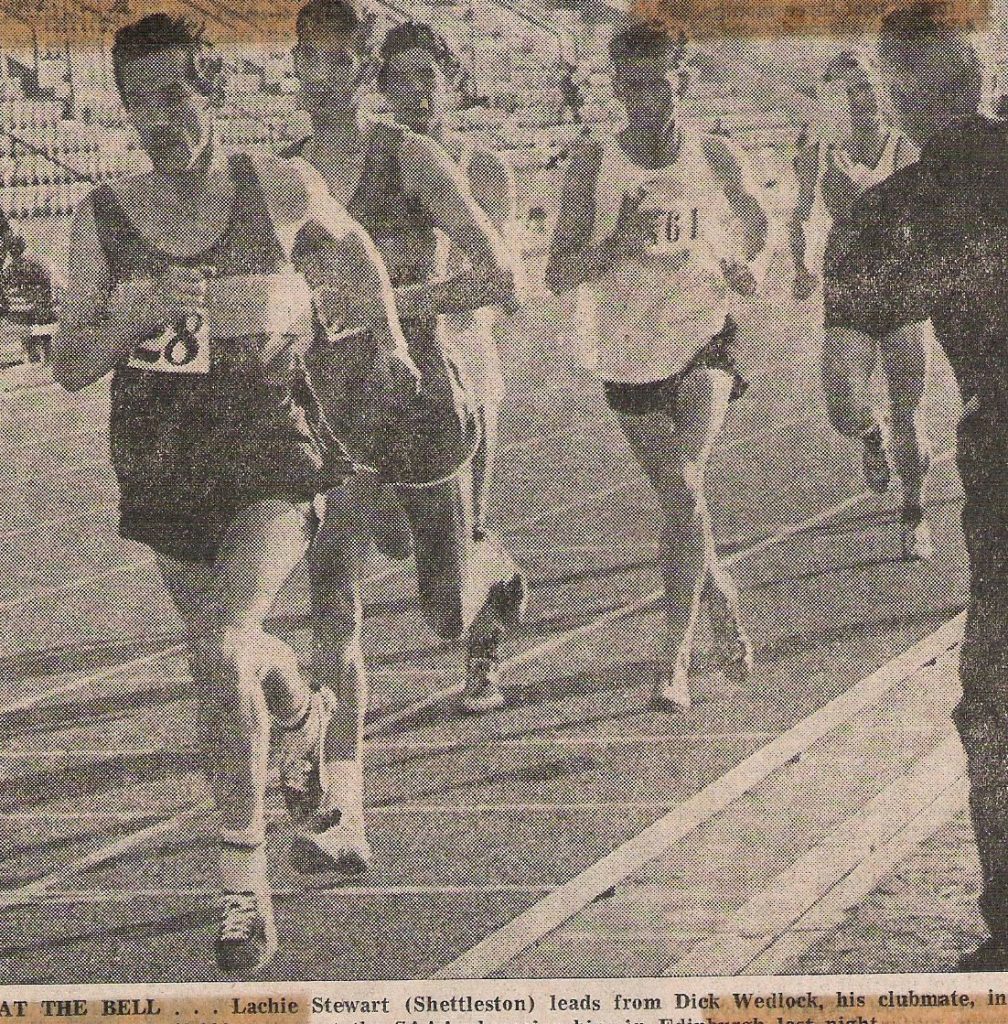
Behind Lachie Stewart and Dick Wedlock but ahead of Allan Faulds in the SAAA 10K
. In August he ran in the long 10 miles at Kirkintilloch Highland Games to be again the club’s first finisher. Three days later he ran the three miles in an inter club with Springburn Harriers where he won the three miles in 14:56 with Ian Donald second in 15:14 on an uneven and oddly shaped track. Two nights later it was the club’s Six Miles Track Championship at Whitecrook and he won in 30:44.6 from Ian Donald in 31:04, Brian McAusland in 31:34 and Bobby Shields in 32:45. (He had already won the club Three Miles championship in 15:15 on the cinders of Whitecrook.) Three good quality races in six days! Not satisfied with that he ran in the Largs to Irvine20 mile road race and finished eighth in a field of over 50 runners. Winter started officially for the Harriers on 23rd September when the McAndrew Trial was held in Clydebank. Ian won this one by more than half a minute from Douglas with Ian a further eight seconds back. This was on a Tuesday and on the Saturday a Two Mile Invitation team race was held on the cramped blaes track at Dumbarton FC at half time. Ian was second to local hero Colin Martin who was in terrific form at this period. A week later was the McAndrew Relay at Scotstoun and Ian was fastest club runner when he was fourth on the first stage in 14:27; Douglas was 14:30 to retain the position on the second stage before Phil Dolan dropped to tenth with 15:43 on third and Ian Donald pulled the club up to sixth with 14:28. Two runners in the second team were faster than Phil – Brian McAusland in 14:39 for thirteenth on the first stage and Bobby Shields on 15:20 who dropped to eighteenth on the second stage. In the County Relays the next week Ian was again fastest in 14:58 with Ian Donald 15:13 to be second fastest in the winning quartet. Back on the roads two weeks later for the club Sinclair Trophy 5 Miles Road Race he was second to Douglas being almost half a minute down.
In the Midlands Relay at Bellshill on 1st November, he was fourth on the first stage in 11:35 which was the fastest club time on the afternoon – 14 seconds ahead of Douglas. A week later he was again first club finisher when he was eighth in the Glasgow University Road Race in 26:25. This was at the time the last road race before the Edinburgh to Glasgow Relay and Ian was asked to run the hard seven miles of the sixth stage. Not only did he run it well but he picked up a place to be thirteenth at the handover. Opposition on that stage included Lachie Stewart, Fergus Murray, Alistair Blamire and Eddie Knox which made it among the classiest that many could remember. On 22nd November he was one of the club’s quartet to contest the inaugural Allan Scally Relay organised by Shettleston Harriers at Baillieston. Shettleston Harriers were winners with all their strongest runners out in this race, Springburn Harriers were second but the Clydesdale team was third with Ian Donald on the first stage fastest club man on 24:50 followed by Bobby Shields on the second stage in 25:39, young Phil Dolan third with 26:10 and Ian having a tussle with Edinburgh Southern Harriers’ Coyle all the way to the finish to give the club third place by two seconds. Ian’s time was 25:11. He says of this one: “Our prize was a hand operated trouser press each. When the Christmas Handicap came round, there were four hand held trouser presses wrapped in Christmas paper in the sack. I always wondered what happened to them.” The next outing was in the County Championships on 6th December where he was fourth – one place behind Ian Donald and one ahead of Douglas Gemmell. That was the end of his year – it had been an excellent twelve months with Ian leading the club contingent home on eighteen occasions. It is fair to say too that at that time Scottish endurance running was on a high and the Clydesdale team was also very strong. In 1969 Ian was probably the best and most consistent runner in the club.
1970 started with Allan Faulds joining the club and this strengthened the club immensely but simultaneously made life harder for everybody else – in the best possible way. Straight away he won the club championship on 7th February and Ian was second a mere four seconds back. The local press reported it as follows:
“Allan Faulds who joined us recently had his first race and proved his fitness by fighting off persistent pressure and challenges from Ian Leggett. Even to the last few hundred yards the result was in doubt but Allan was strong enough to get in front to get clear to win by four seconds.” Allan’s time was 43:47 and Ian’s 43:51. Ian went on to be first counter in the County and District Championships but came the National Championships and Allan was first club man home when he was twenty seventh and Ian was four places adrift.
His running between 1969 and 1972 in the County Relay and Championship shows his form at this time in close up. He ran both in the relays and championships in 1969 being fastest club man in the winning relay team and finishing third in the Championship. In January 1970 Ian led the County contingent home in the Inter Counties Cross Country Championship when he was eleventh. In October, he was again in the winning relay team as second fastest club runner and then finished second in the Championship leading the team to second place. A year later and he again in the winning relay team and was third in the Championship. In ’72 he missed the relays and was eighth in the Championships and in ’73 was again in the winning relay team with fifth place in the championship. Came 1974 and he was in the relay team that finished second and his thirteenth place in the Championships helped the team to second place. His next appearance at the County Relays was in October 1977 when he was in the winning relay team with Doug Gemmell, Phil Dolan and Robert McWatt. In the Championships that year he was thirteenth and out of the team medals. That was his last run in any County event over the country before his move to Livingston. He had run in seven County relay teams which won 5 gold medals and one silver, and in seven County Championship teams which won four gold and two silver after he returned from Australia. An excellent record of quality runs for the club.
Ian’s running and racing was always at a high level with good races and times. If you are looking for the complete endurance runner, Ian is an obvious role model. He ran ~
on the road at all distances up to the marathon;
on the track up to and including the 10, 000 metres;
on the hills he raced the Mamore and Ben Nevis races;
all championships for which he was eligible – club, county, district and national;
over the country he was a member of Scottish representative and select teams that competed against other regions around Britain over the country, represented the West of Scotland in the inter area match and represented Dunbartonshire in the annual inter counties track fixture.
He raced as much as any club member that I can remember and travelled all over Scotland to get to the races – local ones like the Balloch and the Helensburgh, Fort William and Kinlochleven for the big hill races, the middle distance ones like the Tom Scott at Motherwell, longer ones like Largs to Irvine, marathon races at Meadowbank and at Shettleston and many more. He sought out the competition – he didn’t shy away from it like so many. But wherever he ran the quality was evident – for instance he ran in the last ever Marathon Club 12 Miles Road Race at Springburn winning it from Falkirk’s Willie Day: the next year the race was transformed into the Luddon Half Marathon.
In the Edinburgh to Glasgow he ran the second stage in 1964 in his first ever race in the event and dropped seven places against runners who were too good for him at that point – he should probably never have been asked to run that stage. He himself says of it: “Personally the most disappointing race of my life was my first Edinburgh to Glasgow Relay. I didn’t realise what I was letting myself in for. This leg was full of international runners and first class runners. I finished in nineteenth place out of twenty. I ran straight into the nearest tenement close at the finish and if it wasn’t for Frank Kielty I would have missed the changing bus.” On his return from Australia he ran the long sixth stage in 1969 and then followed his best three years in the race. His happiest memory of the race was 1970 when we finished sixth and won the medals for the most meritorious unplaced performance. He ran on the third stage, had the sixth fastest time and remembers passing John Robson of Edinburgh Southern Harriers hanging over a fence at the A89 junction totally psyched out with other ESH members trying to get him back into the race; the next year he was seventh fastest on the fourth stage and in 1972 he ran into sixth place on the first stage. This three year spell coincided with his best years on the country at County, District and National level.
In general he just did what he did best – running all over the country, doing his considerable best and enjoying it. He says about persona best times: “I didn’t keep too close a note of my pb’s. I know that in Australia my best half mile was 2:08 and mile was 4:38. I ran a 33:33 10K at Westerlands – I think it was a West District Championship; on the road my best half marathon was at the Babcock and Wilcox Sports where I was pipped by Alistair Johnston in the last mile. Both of us broke Andy Brown’s record for the course. My best marathon was in Glasgow in 1984 where I ran twelfth, close to 2:30 and didn’t get a prize as first vet was Donald McGregor in eighth.
Although he never won the club cross country championship – the best ever club athlete not to have this honour – he did win several trophies.
- The Dan MacDonald Cup which is awarded for points scored in County, District and National Relay and Championships was won in 1969 and 1970. This was a hard one to win at a time when the club was so strong in the events in question;
- The Harold Wright Memorial Trophy awarded to the first senior to finish in the National Cross Country Championship was won in 1969 making Ian the first ever winner;
- The Willie Gardiner Quaich for the Outstanding Club Athlete was also won in 1969;
- The Hannah Cup for the fastest time in the club 6 mile cross country handicap race was won in 1970.
- The Dunbartonshire Cup for the first club runner to finish in the Balloch to Clydebank Road Race.
Ian and his wife Cathie were a popular couple who came to all the club functions and were among a group with Ian and Helen Donald, David and Evelyn Bowman and Brian and Betty McAusland who attended Marathon club dinners every year. It was a loss in every sense to the club when they moved to Livingston and Ian joined the local club in the late 70’s. In 1981 when the World Veterans Road Running Championships were held in Glasgow he ran in the 10,000 metres on the Saturday and then turned out in the marathon the following morning. He has kept on running and racing all over the country with many races for the Scottish Veterans in Championships and representative races all over the British Isles. Despite starting later than many, he has had the longest competitive career of any member of the teams of the 1970’s. Even today at almost 70 he is still racing well and regularly.
He says “I still enjoy competing in our sport immensely. I owe a great debt to the boys of Clydesdale Harriers who set the standards and helped me on my road. We had it good in our heyday without realising it and I raise a glass to the boys who are no longer with us and to the ones who still carry the famous ‘C’
I agree with him that we did have it good in our heyday with good winter quarters and a very good training track in summer – would that the club had them again – but like everything else it is the company that made the wee bit extra difference. The runners all got on well together, they trained together and there was great team spirit. Ian had a lot to do with that with his sense of humour and reliability. Any club would have benefited from his presence. A final wee tale from Ian:
“The quirkiest race I ever ran was inside Barlinnie Prison. It was an invitation event to raise funds for an HIV testing unit within the complex. Rangers’ players such as Terry Butcher, Celtic players and others from the boxing and broadcasting world plus some mixed ability runners and privileged inmates made up the field. We were met at the gate and taken to our changing facilities and the prison officer had great pride in telling us that these were the gallows and it was the last place that an execution had ever been performed. Eventually we lined up at the start with the inmates conspicuous in their white T-shirts and black plimsolls. The course was five laps round the cellblock and the Governor who was 6’6” tall and just as broad started the race. No starting pistol here – just a burst paper bag. Off went the inmates like the doors had been left open and paying for their lack of pace judgment on the first lap. The rest of the inmates in their cells rattled their tin mugs against the bars: it was like a Japanese prisoner of war movie. The result was irrelevant and after a shower in the gallows and a nice meal, I was more than relieved to hear the gates close behind me on the way home”.
(There is a review of Ian’s career up to and including the M70 age group at http://www.scottishdistancerunninghistory.scot/ian-leggett/ )
Showing the colours in Australia
